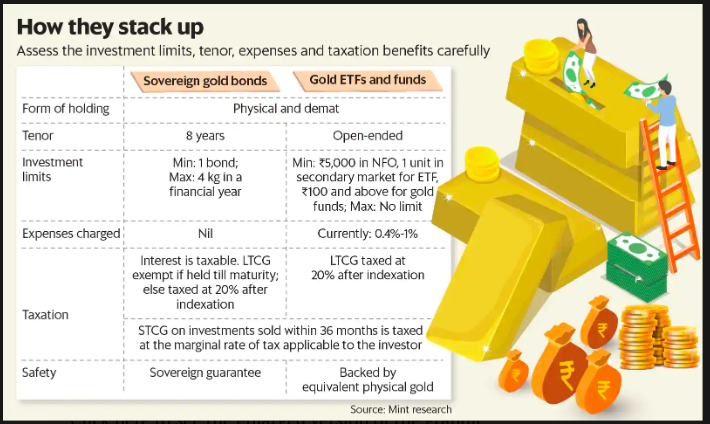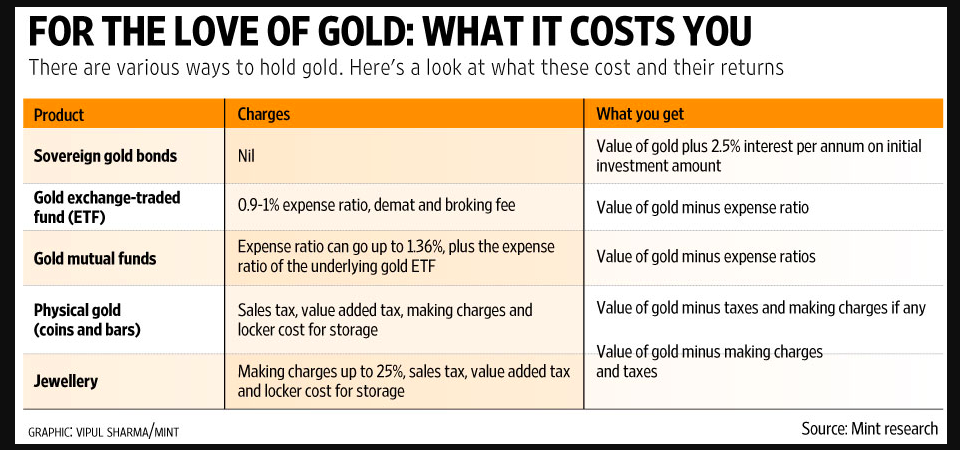Gold, the yellow metal has from time immemorial been one of the most sought-after precious commodities. But owing gold or investing in gold need not necessarily be limited to owning it by way of jewellry. There are different ways of investing in gold. Gold is used as a way to diversify risk by investors. It brings in the element of stability to a portfolio when other asset classes have taken a hit. Thus, it plays a key role in asset allocation.
How to Invest in Gold?
Physical form:
Gold is often bought as jewelry but this may not be the greatest way to invest because of the costs involved in making them and the value attached to jewellry. It becomes less of an investment and has a greater sentimental value to it. However, physical gold also involves owning it by way of coins or bars. There are gold coi schemes by several banks, NBFCs and jewellers. These coins are typically available in denominations of five and ten grams, while the gold bars are of 20 grams. These are hallmarked and are tamper proof.
Gold exchange traded funds (ETFs):
Gold ETFs are akin to buying a certain quantity of gold without actually going to the trouble of physically owning it. There is no risk of owning the physical gold, as it is stored in a paper form. You would need a demat account to trade in gold ETFs. Buying or selling of gold ETFs happens on the stock exchange. If you wish to invest in gold ETFs, you can buy them through your broker with the help of a demat and trading account. You can start with as low as a single unit which is one gram of gold. You can use gold ETFs as collateral if you wish to borrow a loan.
Sovereign gold bonds:
These bonds are issued by India’s central bank, the Reserve Bank of India. They are available in multiples of 1 gm, and an investor can buy up to 4 kg. The bonds are essentially government securities and used as replacement to owning physical gold. The bonds have an eight-year tenure and you can exit in the last three years before the eighth year. Sovereign gold bonds also fetch you a 2.5 per cent interest on the initial investment. These bonds are listed on the stock exchanges and an investor can sell or buy the bonds on the exchange, once the subscription period is over.

Digital gold:
There is one more investment option, ie, digital gold. This is issued by Metals and Minerals Trading Corporation of India (MMTC) in association with Switzerland’s PAMP, a bullion brand. You can buy gold effortlessly on your smartphone via digital wallet platforms. The gold you buy is safeguarded in a storage that is under the custody of MMTC-PAMP. You can keep the gold secure for five years, and take delivery anytime within that period. The gold can be bought as coins of many denominations or bars. The pricing is transparent and is linked to global market rates.
Gold Mutual Fund:
A Gold Mutual Fund is an investment vehicle in India that focuses on gold and gold-related instruments like bullion and coins. Unlike physical gold or Gold ETFs, these funds are managed by financial institutions and invest in various forms of gold assets. They allow investors to benefit from gold’s value without needing to buy physical gold directly.
Gold has long been priced for its ability to hedge against inflation and economic uncertainties, making gold mutual funds popular among Indian investors. One significant advantage is the tax benefit: investments in these funds qualify for long-term capital gains tax exemption if held for more than a year. This makes them an attractive choice for those looking to diversify their investment portfolio with a stable and potentially lucrative asset class like gold.
Physical gold vs other forms of investing :
To sum up, there are many options to invest in gold, including as a physical asset. However, owning physical gold comes at a cost, both in terms of security and in the cost of making them. Sovereign gold bonds come with a set of advantages. They are safe and don’t involve any costs pertaining to storage or making. This investment option is safe because it is issued by the RBI on the government’s behalf. When the bond is withdrawn, upon maturity or before, the investors receive payment at market value of gold at that time. Also, there is no tax on capital gains.

Similarly, owning the precious metal in the form of gold exchange traded funds or ETFs would mean you actually invest in a price that is closer to the actual price of gold. Also, when you invest in gold ETFs, there is no need to worry about adulteration. You can keep track of your investment in real time, and gold exchange traded funds are highly liquid assets to boot. You can enter and exit gold ETFs whenever you wish to. It is among the easiest options if you wish to invest in gold.
If you wish to invest in gold ETFs, all you need to do is open a demat and trading account with a broker. You will be asked to fill in your basic details before you get yourself registered. A demat and trading account with Angel One offers a seamless experience and you can also receive investment tips and health scores that show you how your portfolio is faring. It also offers a smart phone app to make the trading experience fast, smooth and efficient.
What Documents Do You Need to Invest in Gold?
- Physical Gold: A PAN Card is required for investments over ₹2 lakhs.
- Gold ETFs: Open an account with a brokerage firm and a Demat account.
- Sovereign Gold Bonds (SGBs): KYC documents required are Aadhaar, PAN, Voter ID, or Passport.
These requirements ensure proper identification and compliance with regulations for various gold investment methods.
Why to Invest in Gold?
Investing in gold is a smart choice due to its safety, liquidity, and potential for profitable returns. Gold often acts as a refuge of safety during uncertain times, providing stability when other investments may be volatile. It historically aligns with inflation rates, making it an effective hedge against rising costs. Additionally, gold investments are highly liquid, meaning you can easily buy or sell gold as needed. This liquidity ensures you can quickly convert your investment into cash. All things considered, investors looking for stability and security in their portfolios find gold to be a desirable alternative due to its capacity to hold value, provide liquidity, and function as a protective asset.
Conclusion
Investing in gold offers various options tailored to different needs and preferences. Whether through physical gold, ETFs, sovereign gold bonds, or digital gold, each method provides unique advantages. Gold remains a stable and liquid asset, serving as a hedge against inflation and economic uncertainty. By understanding the various investment avenues, you may diversify your portfolio and secure your financial future.
FAQs
How do sovereign gold bonds differ from physical gold?
Sovereign Gold Bonds (SGBs) are government-backed securities offering interest and can be traded on exchanges, whereas physical gold involves direct ownership and requires storage. SGBs eliminate storage concerns and offer additional interest income.
Can I use gold ETFs as loan collateral?
Yes, Gold Exchange-Traded Funds (ETFs) can be used as collateral for loans. They provide a convenient way to leverage your gold investment without the need to physically hold the gold.
What are the benefits of digital gold?
Digital gold allows you to buy, sell, and store gold online securely. It offers the convenience of purchasing small quantities, transparent pricing linked to global rates, and eliminates the need for physical storage.
What should I consider when buying physical gold?
When buying physical gold, consider the costs involved, such as making charges for jewellery and storage expenses. Ensure the gold is hallmarked for purity, and prefer purchasing from reputable sources to avoid issues with authenticity and resale value.






